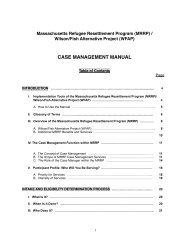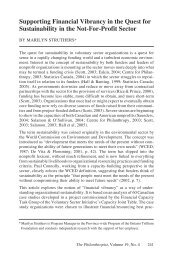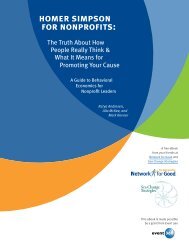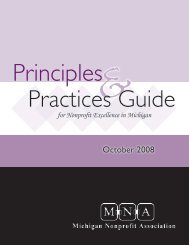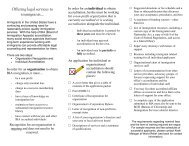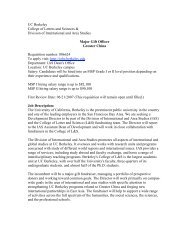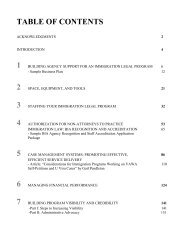Why Bad Presentations Happen to Good Causes - The Goodman ...
Why Bad Presentations Happen to Good Causes - The Goodman ...
Why Bad Presentations Happen to Good Causes - The Goodman ...
Create successful ePaper yourself
Turn your PDF publications into a flip-book with our unique Google optimized e-Paper software.
waiting <strong>to</strong> be shared,” wrote another respondent. “Presenters have a responsibility <strong>to</strong><br />
mine that, direct it, and facilitate the economical sharing of that information among<br />
the group.”<br />
4. Lifeless presenters. Presenters who speak in a mono<strong>to</strong>ne, who seem <strong>to</strong> lack interest in<br />
their own material, or who appear <strong>to</strong> have wandered in from the set of “Night of the<br />
Living Dead” were also reported by many in the survey. “Even if I’m interested in the<br />
<strong>to</strong>pic,” one respondent <strong>to</strong>ld us, “if the speaker is boring, I’m easily distracted by other<br />
goings-on in the room like someone’s cool shoes or outfit. And then I’m <strong>to</strong>tally lost<br />
thinking, ‘I need <strong>to</strong> go shopping!’”<br />
5. Room/technical problems. LCD projec<strong>to</strong>rs that don’t work, air conditioning that<br />
works <strong>to</strong>o well, sound systems that are either <strong>to</strong>o soft, <strong>to</strong>o loud, or have <strong>to</strong>o much hiss<br />
– just about every room or technical problem you can imagine showed up in survey<br />
answers. While equipment breakdowns and room problems are inevitable across<br />
thousands of presentations, many are preventable, and even those that cannot be<br />
avoided do not have <strong>to</strong> ruin a talk. <strong>The</strong> frequency with which respondents mentioned<br />
these kinds of problems suggests that public interest presenters often do not anticipate<br />
them or fail <strong>to</strong> have a backup plan.<br />
Excellence Defined: <strong>The</strong> Three Most Wanted<br />
In another open-ended question, we asked, “What one or two key things make a<br />
presentation excellent?” Again, respondents provided a wide range of answers, although a<br />
few unhappy campers claimed they had never seen an excellent presentation. A consensus<br />
emerged around three characteristics, and unsurprisingly each is a direct opposite of a<br />
common problem cited above.<br />
1. Interaction. Nearly one out of every four respondents mentioned interaction – with the<br />
speaker, with other audience members, or both – as a hallmark of excellent presentations.<br />
“Interactive presentations that create opportunities for the audience members <strong>to</strong> work<br />
<strong>to</strong>gether and with the presenter are almost always <strong>to</strong>p notch,” one respondent <strong>to</strong>ld us.<br />
2. Clarity. Some used the words “well organized,” and some wrote “concise,” but if you<br />
were <strong>to</strong> scan the verbatim responses <strong>to</strong> this question, you would see a long run of<br />
answers that begin with “clarity.” One such response: “Clarity of three <strong>to</strong> four wellframed<br />
key points the speaker wanted the audience <strong>to</strong> take away, coupled with smart<br />
use of metaphors/anecdotes that helped speaker drive them home.”<br />
3. Enthusiasm. Whether respondents used the words energy, passion, charisma, engaging,<br />
dynamic or lively, they all wanted the same thing: presenters who were enthusiastic<br />
about their <strong>to</strong>pic and conveyed that interest <strong>to</strong> the audience.<br />
Four other qualities that each received a high number of mentions were: humor, use of<br />
s<strong>to</strong>ries, relevance, and well-produced visuals.<br />
pg. 11<br />
“When I go <strong>to</strong> most<br />
presentations, I want<br />
<strong>to</strong> die. <strong>The</strong>y’re just reading<br />
<strong>to</strong> me. Give me something <strong>to</strong><br />
do. Make this an experience<br />
I’ll remember. We don’t learn<br />
from facts and figures. We<br />
learn by doing. <strong>The</strong> whole<br />
point of that human being up<br />
on the platform is <strong>to</strong> create<br />
an experience.”<br />
– Christina Harbridge Law<br />
Bridgeport Financial, Inc.



